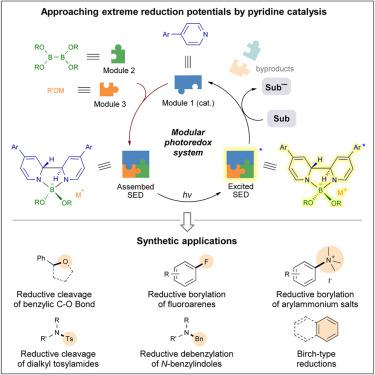Chem ( IF 19.1 ) Pub Date : 2023-07-25 , DOI: 10.1016/j.chempr.2023.06.023 Lutao Bai , Lei Jiao

|
Photoinduced electron transfer is an efficient approach to single-electron reduction of organic molecules for their activation. A variety of molecular photoredox systems have been developed for this purpose, whereas only a few of them exhibit potent reduction abilities required for reducing inert substrates, and more new systems with extreme reduction potentials are highly desirable. Notably, developing a new photoredox system usually requires iterative work on molecular design and synthesis. In this work, we present a conceptually distinct modular photoredox system, which features the in situ formation of a photoredox-active species from three simple modules (a pyridine derivative as catalyst, and a diboron[4] compound and an alcoholate as sacrificial components). This allowed for flexible tuning of its property to approach extreme reduction potentials, enabling a wide range of challenging single-electron reduction reactions. This work extends the utility of pyridine catalysis and serves as the proof of concept of the molecular photoredox system.
中文翻译:

基于吡啶催化的具有极端还原电位的模块化光氧化还原系统
光诱导电子转移是有机分子单电子还原及其活化的有效方法。为此目的,已经开发了多种分子光氧化还原系统,但其中只有少数表现出还原惰性底物所需的有效还原能力,并且非常需要更多具有极端还原潜力的新系统。值得注意的是,开发新的光氧化还原系统通常需要在分子设计和合成方面进行迭代工作。在这项工作中,我们提出了一个概念上不同的模块化光氧化还原系统,其特征是从三个简单模块(吡啶衍生物作为催化剂,二硼[4]化合物和醇化物作为牺牲成分)原位形成光氧化还原活性物质。。这使得可以灵活调整其性能以接近极端还原电位,从而实现各种具有挑战性的单电子还原反应。这项工作扩展了吡啶催化的实用性,并作为分子光氧化还原系统的概念证明。





















































 京公网安备 11010802027423号
京公网安备 11010802027423号